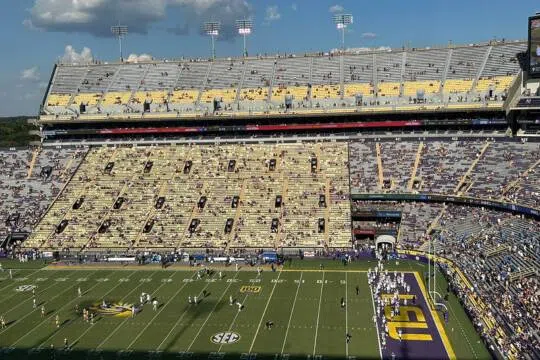By Matt Moscona
BATON ROUGE, La. — As a media member, I have a long-held belief when it comes to criticizing fan attendance: don’t do it. Ever.
Take passion for a team out of the mix for a moment. I collect expensive whiskey (roughly 200 bottles in my office) and sneakers (about 100 pair in my closet). To a lot of people, that probably seems absurd. And I simply don’t care.
I would never spend thousands on shotguns, hunting licenses, boats and fishing trips. People who travel the country to watch their favorite band dozens (or hundreds) of times seems excessive to me. Card collecting was a fun hobby when I was ten, but adults geeking out as they bust boxes seems silly.
And if those are your passions, then you shouldn’t give a single thought to what I or anyone else thinks about it. You do you.
So, when it comes to fan attendance, I feel the same way. Want to show up late and leave early to beat the traffic? Cool. Want to be the first person to scan your ticket and stay until the marshals kick you out? Have at it. Want to buy tickets and use them as toilet paper? Knock yourself out.
Attendance at LSU football games has been a lightning rod topic for the last decade and it reached a crescendo Saturday when LSU hosted UCLA.
You know how fans at neutral site rivalry games are split right down the middle of the stadium? When Texas and Oklahoma play in the Cotton Bowl, half the stadium is burnt orange and the other is crimson and cream. It’s an equal division of red and black and orange and blue when the Gators and Dawgs play in Jacksonville.
That’s what it was like Saturday in Tiger Stadium, only it wasn’t UCLA’s blue and gold making up half the attendance, it was empty seats. It wasn’t team loyalty dividing the crowd, it was shade. The West side of Death Valley was as packed as you would expect in a tie game against a Big Ten opponent. The East side was as empty as if it were a high school game being played there.
Press Box view of LSU-UCLA crowd Saturday.
Look at the scoreboard. It was 17-17 in the 3Q. The West side is packed and the East is empty.
These aren’t bad fans. This was 100% a product of the dangerous heat. pic.twitter.com/nT3gqBUpjC
— LouisianaSportsDotNet (@LASportsDotNet) September 22, 2024
As the heat index in Baton Rouge crossed into triple digits, the ABC broadcast reported the field temperature on the artificial turfed sideline was 130 degrees! Now, imagine sitting on metal bleachers in those conditions for four hours. No, thanks.
Not only is that uncomfortable, it’s dangerous. One report noted more than 70 people needed medical attention due to heat-related issues.
Talked with some medical professionals on my way up to the press box and they said the number of people who have been taken to the “medical room” is north of 70. https://t.co/9hvQhbxkgo
— Bryce Koon (@bryce_koon) September 21, 2024
There are obvious reasons why LSU historically played night games. The tradition began in 1931 for two primary reasons: to allow more fans to attend the games and to avoid the sweltering heat and humidity.
Unfortunately, LSU doesn’t decide kickoff times anymore. When every league member signed their grant-of-rights over to the SEC, they allowed the conference to negotiate television deals on their behalf. The financial benefit is in part what allows SEC schools to build palatial facilities and hire great coaches. The tradeoff is sometimes you play at 2:45 p.m. when there’s record heat in Baton Rouge because the television network told you to.
Dear @espn,
This is what happens when you play 2:30 games in Baton Rouge in September. https://t.co/Lnj9LRgqgI
— Matt Moscona (@MattMoscona) September 21, 2024
You can’t have your cake and eat it too.
Tiger Stadium remains the greatest big game venue in college football and would challenge any in the world. But there are plenty of fall Saturdays against inferior opponents where Tiger faithful empty out early to beat traffic or don’t bother attending at all because the home viewing experience is so good and the FCS opponent being paid to take a whipping isn’t worth the effort of going to the stadium.
LSU, like many other athletic departments, got caught in the stadium expansion arms race just as affordable flat screen TVs and digital streaming were coming into play. They bought a fleet of horses the day before the Model T was invented. Now, they are left with giant stadiums they struggle to fill, and likely never will consistently again.
If you chose to sit it out Saturday, I don’t blame you. And if anyone is criticizing you for doing so, you should ignore them.
Especially if the criticism is coming from media members eating free food in a shaded, air conditioned press box.







